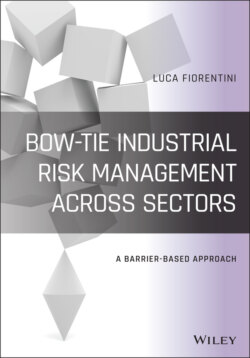Читать книгу Bow-Tie Industrial Risk Management Across Sectors - Luca Marmo, Luca Fiorentini - Страница 14
Preface 1
ОглавлениеRiccardo Ghini
Quality Head Italy & Malta and South Europe Cluster, Sanofi
Risk assessment is a basic concept that has always accompanied me throughout my work and professional experience, so being able to contribute, albeit marginally, to the drafting of this monumental work fills me with pride and happiness.
Since the time of Legislative Decree 626/94, the ability to evaluate the probability of occurrence and the possible consequences of accidents and injuries at work has been a fundamental skill for me to develop, through the study of ever‐more‐refined methods and techniques of investigation. Finding all these useful analysis tools grouped in this way, brilliantly described and accompanied by real application examples, represents for me, and for all professionals, a unique opportunity for enrichment and deepening.
In fact, as my career continued, I soon realized how the concepts underlying this book can be effectively applied, not only in the field of work safety, but also in all areas of business activity, where words like “risk,” “scenario,” “analysis of the causes,” and “continuous improvement” have become commonly used, as they are based on the very structure of the management systems developed in accordance with the various reference standards, now completely standardized.
Furthermore, we mustn’t fail to mention the importance assumed by the methods of analysis, assessment, and operational management of the risks associated with the predicate offenses of Legislative Decree 231/2001 (administrative liability of companies and entities), which constitute the essential element in the preparation of a Corporate Organization, Management, and Control Model that effectively prevents the occurrence of the types of offense and, at the same time, constitutes a valid exemption in the context of a possible criminal trial.
The real cultural transition, however, takes place when the concept of risk assessment is adopted and is also applied outside the professional sphere, elevating it to a rational criterion to guide our daily choices: “do I overtake or not overtake the car that’s in front of me?, “do I subscribe to this insurance policy or not?,” “do I vaccinate my children or not?” These are all questions and situations we face every day, and for which it is very useful to identify the possible “top event,” the “consequences” that can be generated, and the “causes” that can originate it, as well as to know what “barriers” we can implement in our defence.
This book is therefore much more than a scientific text for a few super‐technicians and experts; it is a concrete and useful reference to all, to bring order and reasoning into our decisions, whatever they may be, in a world increasingly dominated by superficiality and disinformation.
I would also like to underline another aspect, often not adequately communicated: the concept of risk not only with a negative meaning, as a threat or weighting of an unfavourable event, but also, from the perspective of ISO 31000, as a positive deviation from the result expected, therefore, as an opportunity, to be evaluated and seized for the development of the organization. A better understanding of this dimension of risk would certainly facilitate a wider and more extensive use of the methodologies illustrated in the book.
At this point, before diving into reading and studying, I just have to applaud the authors, who represent all‐Italian excellence, similar to Ferrari and Parmigiano Reggiano, in this scientific field traditionally the prerogative of Anglo‐Saxon and American schools, and of which we must all be proud.
